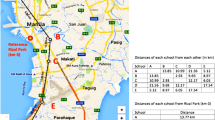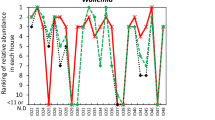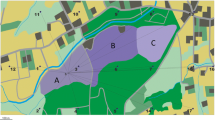Abstract
Conventional microbiological techniques yield only limited information on the composition of fungal communities in dust. The aim of this study was to establish and optimize PCR-single strand conformation polymorphism (PCR–SSCP) analysis for investigation of fungal diversity in rural dust samples. Three different DNA extraction protocols were tested on 38 fungal cultures. A total of six known universal fungal primer pairs were tested targeting the 18S rRNA gene, the 28S rRNA gene and the ITS region, respectively. Objective evaluation was performed with respect to the following parameters: efficiency to amplify all 38 strains; separation of seven species from different phylogenetic groups on the SSCP gel; additional bands in PCR–SSCP analysis; possibility to classify the amplified gene fragments to species level. Primer ITS1/ITS4 and PowerSoil™ DNA isolation showed the best performance in most cases and were chosen for further analysis. The detection limit of the developed system was 200 CFU/g dust. Moreover, the reproducibility of the system could be demonstrated, leading to average profile similarities of 94.94 % [SD = 2.51] within gels, 93.03 % [SD = 4.69] between different days and 87.66 % [SD = 6.62] between different gels when testing shed and mattress dust samples. Sequencing allowed identification on species level, in detail: Alternaria alternata, Cladosporium sphaerospermum, Cladosporium cladosporioides as well as the yeasts Candida cabralensis and Candida catenulata. This demonstrates the adaptability of the method. In this study, a standardized system for fungal community analysis was developed that provides reproducible results applicable for epidemiological purposes.


Similar content being viewed by others
Change history
24 August 2019
The original version of this article contained a mistake in the co-author���s conflict of interest statement. Erika von Mutius wishes to add the following disclosures: ���E. von Mutius is listed as an inventor on the following patents: publication number EP 1411977, composition containing bacterial antigens used for the prophylaxis and the treatment of allergic diseases, granted on 18 April 2007; publication number EP1637147, stable dust extract for allergy protection, granted on 10 December 2008; publication number EP 1964570, pharmaceutical compound to protect against allergies and inflammatory diseases, granted on 21 November 2012. E. von Mutius is listed as inventor and has received royalties on the following patent: publication number EP2361632, specific environmental bacteria for the protection from and/or the treatment of allergic, chronic inflammatory and/or autoimmune disorders, granted on 19 March 2014���.
24 August 2019
The original version of this article contained a mistake in the co-author���s conflict of interest statement. Erika von Mutius wishes to add the following disclosures: ���E. von Mutius is listed as an inventor on the following patents: publication number EP 1411977, composition containing bacterial antigens used for the prophylaxis and the treatment of allergic diseases, granted on 18 April 2007; publication number EP1637147, stable dust extract for allergy protection, granted on 10 December 2008; publication number EP 1964570, pharmaceutical compound to protect against allergies and inflammatory diseases, granted on 21 November 2012. E. von Mutius is listed as inventor and has received royalties on the following patent: publication number EP2361632, specific environmental bacteria for the protection from and/or the treatment of allergic, chronic inflammatory and/or autoimmune disorders, granted on 19 March 2014���.
Abbreviations
- ARISA:
-
Automated ribosomal intergenic spacer analysis
- CFU:
-
Colony forming unit
- CTAB:
-
Cetyltrimethylammoniumbromid
- DGGE:
-
Denaturing gradient gel electrophoresis
- DSMZ:
-
German collection of microorganisms and cell cultures
- EPS:
-
Exopolysaccharide
- ITS:
-
Internal transcribed spacer
- LSU:
-
Large-subunit
- PCR:
-
Polymerase chain reaction
- SSCP:
-
Single-strand conformation polymorphism
- SSU:
-
Small-subunit
References
Amann RI, Ludwig W, Schleifer KH (1995) Phylogenetic identification and in situ detection of individual microbial cells without cultivation. Microbiol Rev 59:143–169
Anderson IC, Cairney JWG (2004) Diversity and ecology of soil fungal communities: increased understanding through the application of molecular techniques. Environ Microbiol 6:769–779
Anderson IC, Campbell CD, Prosser JI (2003) Potential bias of fungal 18S rDNA and internal transcribed spacer polymerase chain reaction primers for estimating fungal biodiversity in soil. Environ Microbiol 5:36–47
Atkinson L, Adams ES (1997) Double-stranded conformation polymorphism (DSCP) analysis of the mitochondrial control region generates high variable markers for population studies in a social insect. Insect Mol Biol 6:369–376
Bassam BJ, Caetano-Anollés G, Gresshoff PM (1991) Fast and sensitive silver staining of DNA in polyacrylamide gels. Anal Biochem 196:80–83
Beguin H, Nolard N (1996) Prevalence of fungi in carpeted floor environment: analysis of dust samples from living-rooms, bedrooms, offices and school classrooms. Int J Aero 12:113–120
Borneman J, Hartin RJ (2000) PCR primers that amplify fungal rRNA genes from environmental samples. Appl Environ Microbiol 66:4356–4360
Braun-Fahrländer C, Riedler J, Herz U, Eder W, Waser M, Grize L, Maisch S, Carr D, Gerlach F, Bufe A, Lauener RP, Schierl R, Renz H, Nowak D, von Mutius E (2002) Environmental exposure to endotoxin and its relation to asthma in school-age children. N Engl J Med 347:869–877
Braun-Fahrländer C, Lauener RP (2003) Farming and protective agents against allergy and asthma. Clin Exp Allergy 33:409–411
Brodie E, Edwards S, Clipson N (2003) Soil fungal community structure in a temperate upland grassland soil. FEMS Microbiol Ecol 45:105–114
Dales RE, Miller D, McMullen ED (1997) Indoor air quality and health: validity and determinants of reported home dampness and moulds. Int J Epidemiol 26:120–125
Debarry J, Garn H, Hanuszkiewicz A, Dickgreber N, Blümer N, von Mutius E, Bufe E, Gatermann S, Renz H, Holst O, Heine H (2007) Acinetobacter lwoffii and Lactococcus lactis strains, isolated from farm cowsheds possess strong allergy-protective properties. J Allergy Clin Immunol 119:1514–1521
Dohrmann AB, Tebbe CC (2004) Microbial community analysis by PCR–single-strand conformation polymorphism (PCR–SSCP). In: Kowalschuk GA, de Bruijn FJ, Head IM, Akkermans AD, van Elsas JD (eds) Molecular microbial ecology manual. Kluwer Academic, Dordrecht, pp 809–838
Dorn-In S, Hölzel CS, Janke T, Schwaiger K, Balsliemke J, Bauer J (2013) PCR–SSCP-based reconstruction of the original fungal flora of heat-processed meat products. Int J Food Microbiol 162:71–81
Douwes J, van der Sluis B, Doekes G, van Leusden F, Wijnands L, van Strien R, Verhoeff A, Brunekreef B (1999) Fungal extracellular polysaccharides in house dust as a marker for exposure to fungi: relations between culturable fungi, reported home dampness, and respiratory symptoms. J Allergy Clin Immunol 103:494–500
Douwes J, Thorne P, Pearce N, Heederik (2003) Bioaerosol health effects and exposure assessment: progress and prospects. Ann Occup Hyg 47:187–200
Du X-H, Zhao Q, Yang ZL, Hansen K, Taskin H, Büyükalaca S, Dewsbury D, Moncalvo J-M, Douhan GW, Robert VA, Crous PW, Rehner SA, Rooney AP, Sink S, O’Donnell K (2012) How well do ITS rDNA sequences differentiate species of true morels (Morchella)? Mycologia 104:1351–1368
Ege MJ, Biele C, Frei R, van Strien RT, Riedler J, Ublagger E, Schram-Bijkerk D, Brunekreef B, van Hage M, Scheynius A, Pershagen G, Benz MR, Lauener RP, von Mutius E, Braun-Fahrländer C, Parsifal Study Team (2006) Prenatal farm exposure is related to the expression of receptors of the innate immunity and to atopic sensitization in school-age children. J Allergy Clin Immunol 117:817–823
Ege MJ, Mayer M, Normand A-C, Genuneit J, Cooksen WOCM, Braun-Fahrländer C, Heederik D, Piarroux R, von Mutius E, for the GABRIELA Transregio 22 Study Group (2011) Exposure to environmental microorganisms and childhood asthma. N Engl J Med 364:701–709
Fisher MM, Triplett EW (1999) Automated approach for ribosomal intergenic spacer analysis of microbial diversity and its application to freshwater bacterial communities. Appl Environ Microbiol 65:4630–4636
Gardes M, Bruns TD (1993) ITS primers with enhanced specificity for basidiomycetes: application to the identification of mycorrhiza and rusts. Mol Ecol 2:113–118
Hayashi K (1991) PCR–SSCP: a simple and sensitive method for detection of mutations in the genomic DNA. PCR Methods Appl 1:34–38
Hayashi K, Yandell DW (1993) How sensitive is PCR–SSCP? Hum Mutat 2:338–346
Hayashi K (1997) Recent enhancements in SSCP. Genet Anal Biomol Eng 14:193–196
Iwen PC, Hinrichs SH, Rupp ME (2002) Utilization of the internal transcribed spacer region as molecular targets to detect and identify human fungal pathogens. Med Mycol 40:87–109
Kerr JR, Curran MD (1996) Applications of polymerase chain reaction–single stranded conformation polymorphism to microbiology. J Clin Pathol 49:M315–M320
Korthals M, Ege MJ, Tebbe CC, von Mutius E, Bauer J (2008) Application of PCR–SSCP for molecular epidemiological studies on the exposure of farm children to bacteria in environmental dust. J Microbiol Methods 73:49–56
Kumar M, Shukla PK (2005) Use of PCR-targeting of internal transcribed spacer regions and single-stranded conformation polymorphism analysis of sequence variation in different regions of rRNA genes in fungi for rapid diagnosis of mycotic keratitis. J Clin Microbiol 43:662–668
Kumeda Y, Asao T (1996) Single-strand conformation polymorphism analysis of PCR amplified ribosomal DNA internal transcribed spacers to differentiate species of Aspergillus section flavi. Appl Environ Microbiol 62:2947–2952
Lakay FM, Botha A, Prior BA (2007) Comparative analysis of environmental DNA extraction and purification methods from different humic acid-rich soils. J Appl Microbiol 102:265–273
Larena I, Salazar O, Gonzáles V, Julián MC, Rubio V (1999) Design of a primer for ribosomal DNA internal transcribed spacer with enhanced specificity for ascomycetes. J Biotechnol 75:187–197
Bvd Lustgraaf (1978) Seasonal abundance of xerophilic fungi and house-dust mites (Acarida: pyroglyphidae) in mattress dust. Oecologia 36:81–91
Lyautey E, Teissier S, Charcosset J-Y, Rols J-L, Garabétian F (2003) Bacterial diversity of epilithic biofilm assemblages of an anthropised river section, assessed by DGGE analysis of a 16S rDNA fragment. Aqua Microb Biol 33:217–224
Maccaferri S, Biagi E, Brigidi P (2011) Metagenomics: key to human gut microbiota. Dig Dis 29:525–530
Müller F-MC, Werner KE, Kasai M, Francesconi A, Chanock SJ, Walsh TJ (1998) Rapid extraction of genomic DNA from medically important yeasts and filamentous fungi by high-speed cell disruption. J Clin Microbiol 36:1625–1629
Normand A-C, Vacheyrou M, Sudre B, Heederik DJ, Piarroux R (2009) Assessment of dust sampling methods for the study of cultivable-microorganism exposure in stables. Appl Environ Microbiol 75:7617–7623
O’Connor GT, Walter M, Mitchell H, Kattap M, Morgan WJ, Gruchalla RS, Pongracic JA, Smartt E, Stout JW, Evans R, Crain EF, Burge HA (2004) Airborne fungi in the homes of children with asthma in low-income urban communities: the inner-city asthma study. J Allergy Clin Immunol 114:599–606
Orita M, Suzuki Y, Sekiya T, Hayashi K (1989) Rapid and sensitive detection of point mutations and DNA polymorphisms using the polymerase chain reaction. Genomics 5:874–879
Ortí G, Hare MP, Avise JC (1997) Detection and isolation of nuclear haplotypes by PCR–SSCP. Mol Ecol 6:575–580
Peters S, Koschinsky S, Schwieger F, Tebbe CC (2000) Succession of microbial communities during hot composting as detected by PCR-single-strand-conformation polymorphism-based genetic profiles of small-subunit rRNA genes. Appl Environ Microbiol 66:930–936
Pitkäranta M, Meklin T, Hyvärinen A, Paulin L, Auvinen P, Nevalainen A, Rintala H (2008) Analysis of fungal flora in indoor dust by ribosomal DNA sequence analysis, quantitative PCR and culture. Appl Environ Microbiol 74:233–244
Powell SM, Bowman JP, Snape I, Stark JS (2003) Microbial community variation in pristine and polluted nearshore Antarctic sediments. FEMS Microbiol Ecol 45:135–145
Radon K, Peters A, Praml G, Ehrenstein V, Schulze A, Hehl O, Nowak D (2004) Livestock odours and quality of life of neighbouring residents. Ann Agric Environ Med 11:59–62
Radon K, Schulze A, Nowak D (2006) Inverse association between farm animal contact and respiratory allergies in adulthood: protection, underreporting or selection? Allergy 61:443–446
Riedler J, Braun-Fahrländer C, Eder W, Schreuer M, Waser M, Maisch S, Carr D, Schierl R, Nowak D, von Mutius E, ALEX study team (2001) Exposure to farming in early life and development of asthma and allergy: a cross-sectional survey. Lancet 358:1129–1133
Rintala H, Pitkäranta M, Täubel M (2012) Microbial communities associated with house dust. Adv Appl Microbiol 78:75–120
Roose-Amsaleg CL, Garnier-Sillam E, Harry M (2001) Extraction and purification of microbial DNA from soil and sediment samples. Appl Soil Ecol 18:47–60
Ryberg M, Nilsson RH, Kristiansson E, Töpel M, Jacobsson S, Larsson E (2008) Mining metadata from unidentified ITS sequences in GenBank: a case study in Inocybe (Basidiomycota). BMC Evol Biol 8:50–64
Sandhu GS, Kline BC, Stockman L, Roberts GD (1995) Molecular probes for diagnosis and fungal infections. J Clin Microbiol 33:2913–2919
Schoch CL, Seifert KA, Huhndorf S, Robert V, Spouge JL, Levesque CA, Chen W, and Fungal Barcoding Consortium (2012) Nuclear ribosomal internal transcribed spacer (ITS) region as a universal DNA barcode marker for Fungi. PNAS 109:6241–6246
Schwieger F, Tebbe CC (1998) A new approach to utilize PCR-single-strand conformation polymorphism for 16S rDNA gene-based microbial community analysis. Appl Environ Microbiol 64:4870–4876
Sheffield VC, Beck JS, Kwitek AE, Sandstrom DW, Stone EM (1993) The sensitivity of single-strand conformation polymorphism analysis for the detection of single base substitutions. Genomics 16:325–332
Shendell DG, Mizan SS, Yamamoto N, Peccia J (2012) Associations between quantitative measures of fungi in home floor dust and lung function among older adults with chronic respiratory disease. J Asthma 46:502–509
Singh J, Schwartz DA (2005) Endotoxin and the lung: insight into the host-environment interaction. J Allergy Clin Immunol 115:330–333
Smalla K, Oros-Sichler M, Milling A, Heuer H, Baumgarte S, Becker R, Neuber G, Kropf S, Ulrich A, Tebbe CC (2007) Bacterial diversity of soil assessed by DGGE, T-RFLP and SSCP fingerprints of PCR amplified 16S rRNA gene fragments: do the different methods provide similar results? J Microbiol Methods 69:470–479
Smit E, Leeflang P, Glandorf B, van Elsas JD, Wernars K (1999) Analysis of fungal diversity in the wheat rhizosphere by sequencing of cloned PCR-amplified genes encoding 18S rRNA and temperature gradient gel electrophoresis. Appl Environ Microbiol 65:2614–2621
Stackebrandt E, Goebel BM (1994) Taxonomic note: a place for DNA–DNA reassociation and 16S rRNA sequence analysis in the present species definition in bacteriology. Int J Syst Evol Microbiol 44:846–849
Sunnucks P, Wilson ACC, Beheregaray LB, Zenger K, French J, Taylor AC (2000) SSCP is not so difficult: the application and utility of single-stranded conformation polymorphism in evolutionary biology and molecular ecology. Mol Ecol 9:1699–1710
Turin L, Riva F, Galbiati G, Cainelli T (2000) Fast, simple and highly sensitive double-rounded polymerase chain reaction assay to detect medically relevant fungi in dermatological specimens. Eur J Clin Invest 30:511–518
van Burik JH, Schreckhise RW, Myerson D, White TC, Bowden RA (1997) Comparison of six extraction techniques for isolation of DNA from filamentous fungi. Abstract F-12, p. 262. In: abstracts of the 97th general meeting of the American Society for Microbiology. American Society for Microbiology, Washington, D.C
Velegraki A, Kambouris ME, Skiniotis G, Savala M, Mitroussia-Ziouva A, Legakis NJ (1999) Identification of medically significant fungal genera by polymerase chain reaction followed by restriction enzyme analysis. FEMS Immunol Med Microbiol 23:303–312
Vogel K, Blümer N, Korthals M, Mittelstädt J, Garn H, Ege MJ, von Mutius E, Gatermann S, Bufe A, Goldmann T, Schwaiger K, Renz H, Brandau S, Bauer J, Heine H (2008) Animal shed Bacillus licheniformis spores possess allergy-protective as well as inflammatory properties. J Allergy Clin Immunol 122:307–312
von Mutius E, Braun-Fahrländer C, Schierl R, Riedler J, Ehlemanns S, Maisch S, Waser M, Nowak D (2001) Exposure to endotoxin or other bacterial components might protect against the development of atopy. Clin Exp Allergy 30:1230–1234
Wassenaar DPJ (1988) Effectiveness of vacuum cleaning and wet cleaning in reducing house-dust mites, fungi and mite allergen in a cotton carpet: a case study. Exp Appl Acarol 4:53–62
White TJ, Bruns T, Lee S, Taylor J (1990) Amplification and direct sequencing of fungal ribosomal RNA genes for phylogenetics. In: Innis MA, Gelfand DH, Sninsky JJ, White TJ (eds) PCR Protocols: a guide to methods and applications. Academic Press, San Diego, pp 315–322
Wu Z, Wang X-R, Blomquist G (2002) Evaluation of PCR primers and PCR conditions for specific detection of common airborne fungi. J Environ Monit 4:377–382
Yamamoto N, Shendell DG, Peccia J (2011) Assessing allergenic fungi in house dust by floor wipe sampling and quantitative PCR. Indoor Air 21:521–530
Yamamoto N, Bibby K, Qian J, Hospodsky N, Rismani-Yazdi H, Nazaroff WW, Peccia J (2012) Particle-size distributions and seasonal diversity of allergenic and pathogenic fungi in outdoor air. ISME J 6(10):1801–1811
Zachow C, Berg C, Müller H, Meincke R, Komon-Zelazowska M, Druzhinina IS, Kubicek CP, Berg G (2009) Fungal diversity in the rhizosphere of endemic plant species of Tenerife (Canary Islands): relationship to vegetation zones and environmental factors. ISME J 3:79–92
Acknowledgments
This study was supported by “Sonderforschungsbereich Transregio 22” from the Deutsche Forschungsgesellschaft. We gratefully thank Ms. Barbara Fritz from the Technische Universität München (TUM) for excellent technical assistance as well as the TUM Graduate School for backup support.
Conflict of interest
Authors have no conflict of interest
Funding Sources
Financial support by the Deutsche Forschungsgesellschaft (SFB/TR 22).
Author information
Authors and Affiliations
Corresponding author
Rights and permissions
About this article
Cite this article
Janke, T., Schwaiger, K., Ege, M. et al. Analysis of the Fungal Flora in Environmental Dust Samples by PCR–SSCP Method. Curr Microbiol 67, 156–169 (2013). https://doi.org/10.1007/s00284-013-0344-3
Received:
Accepted:
Published:
Issue Date:
DOI: https://doi.org/10.1007/s00284-013-0344-3




